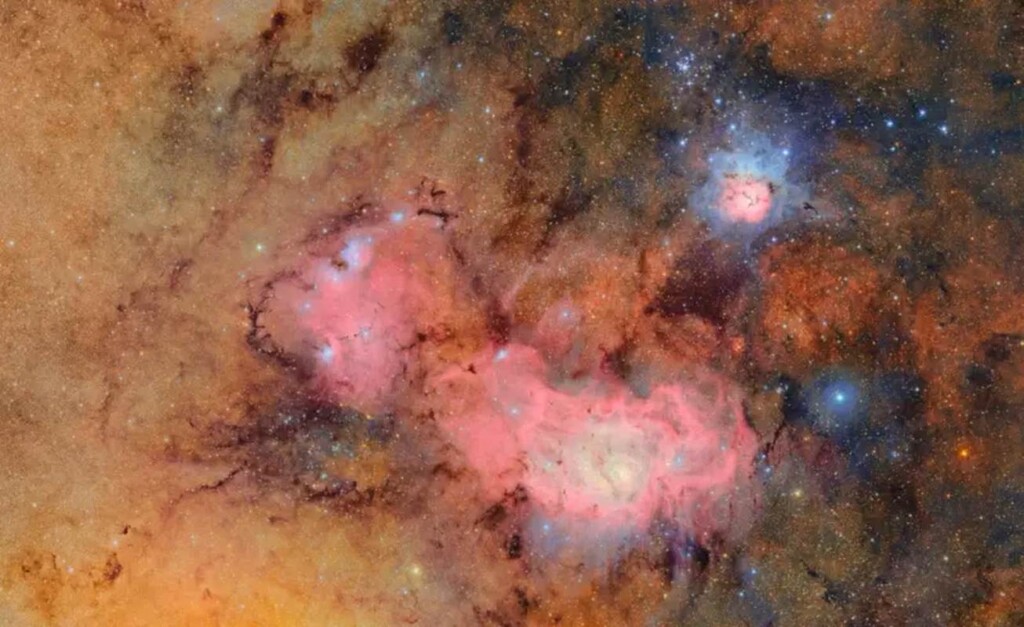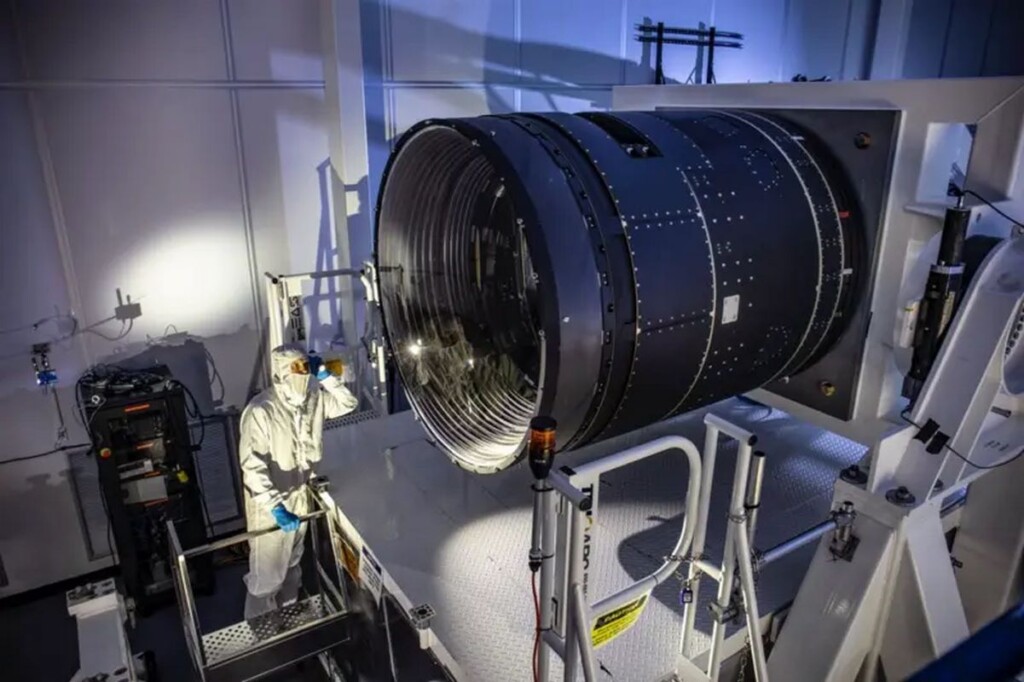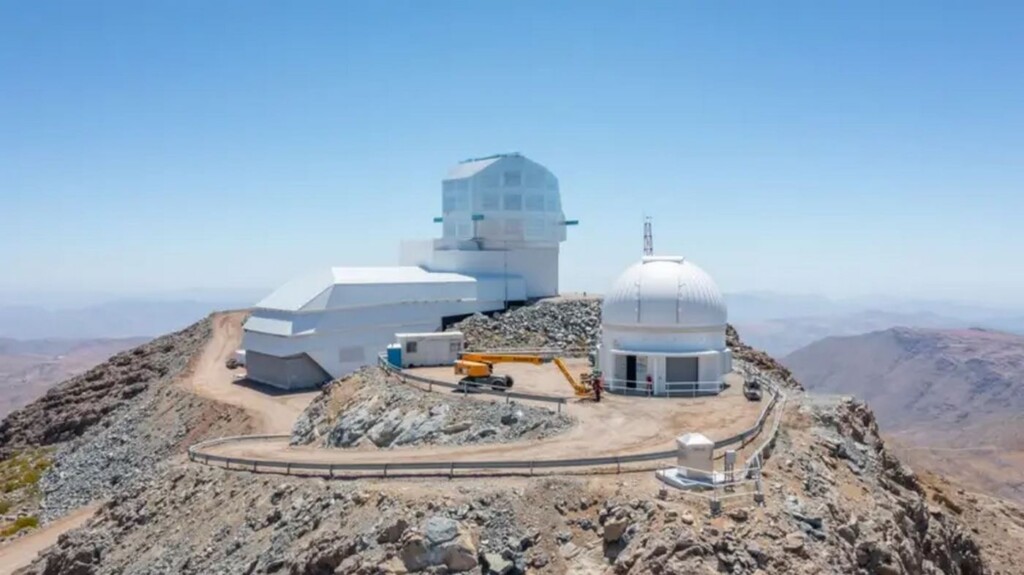 The Tifrid and Lagoon nebulae – credit NSF-DOE Vera C. Rubin Observatory
The Tifrid and Lagoon nebulae – credit NSF-DOE Vera C. Rubin ObservatoryYour iPhone 16 camera has 48 megapixels. Astronomy’s latest toy has 3,200.
That’s because the Vera C. Rubin Observatory in Chile has to be able to image a framing of the night sky as large as seven full moons side to side. It has to be able to do this because of its unique mission set, one which will compliment other observatories while adding in unprecedented capabilities.
 The observatory’s 3.2 gigapixel camera – credit NSF-DOE Vera C. Rubin Observatory
The observatory’s 3.2 gigapixel camera – credit NSF-DOE Vera C. Rubin ObservatoryA perfect example of this is a statistic from a press statement on Monday, when the observatory debuted its first night of photos. It had detected 2,100 new asteroids, including seven which are considered to have near-Earth orbits.
That’s 10% of what all ground and space telescopes do in a whole year of observing the night sky. Vera Rubin was built to see these asteroids for planetary defense. NASA already proved with the DART spacecraft that it can divert potentially harmful asteroids, but it can’t divert what it doesn’t know is there, and Rubin will illuminate that blind spot.
When not working to keep the planet safe, it will be conducting a mammoth undertaking known as the Legacy Survey of Space and Time, which will see it image the entire night sky from its perch over 8,000 feet atop Cerro Pachón every three to four nights for the next 10 years.
This will create a colossal dataset of the current positions of galaxies and stars, which can then be examined for changes that reflect the impact of dark energy and dark matter—mysterious forces which are believed to have greatly influenced the dispersion of galaxies across the universe.
Dark energy and dark matter are believed to make up 90% or so of the universe’s total matter content. They were the study of the astronomer Vera C. Rubin, whose contributions to the field are reflected in the choice of name for the important observatory.
Along with a section of the universe, the dataset will allow researchers to detect minute changes in locales as close as our own solar system, or our nearest galactic neighbors. Any detected changes—a new transient object, a fast radio burst, a new supernova, and an astronomer could be alerted, and new research be conducted in as real time as can be garnered in the discipline that studies in light years.
Professor Catherine Heymans, Astronomer Royal for Scotland, described to the BBC that this transience is going to be a “transformative” resource for the field.
 An image of a large galaxy cluster – credit NSF-DOE Vera C. Rubin Observatory
An image of a large galaxy cluster – credit NSF-DOE Vera C. Rubin ObservatoryAt $473 million, it was a steal compared to the James Webb Space Telescope which ran well into the billions. But the bargain basement observatory wasn’t a fast build; rather an intergenerational project.
“When we got the first photo up here, it was a special moment,” optics technician Guillem Megias told the BBC.
 The observatory’s perch high in the Chilean altiplano – credit NSF-DOE Vera C. Rubin Observatory
The observatory’s perch high in the Chilean altiplano – credit NSF-DOE Vera C. Rubin Observatory“When I first started working with this project, I met someone who had been working on it since 1996. I was born in 1997. It makes you realize this is an endeavor of a generation of astronomers.”
NEW SPACE PROJECTS: This Stunning Perspective of the Sun and Moon Comes from New NASA Mission Set to Study Solar Wind
Yet another question the Vera Rubin Observatory should answer is the speculative existence of a ninth planet in our solar system. A long-held theory lacking compelling evidence, the incredible scope of imaging that the observatory’s 3,200 megapixel camera offers, with its 24-foot-long primary mirror, should resolve the debate within a year in the affirmative or negative.
While the James Webb Space Telescope has dazzled Earthlings with its zoomed-in pictures taken in infrared of faraway galaxies and glittering nebulae, it has the observation potential of a person holding a grain of rice up to the sky and closing one eye to ensure it blocks their sight of the rice grain-sized piece of outer space behind it.
SOME OF WEBB’S RECENT WORK: New James Webb Image Shows ‘Crowded, Tumultuous’ Heart of Our Galaxy in Never-Before-Seen Detail
By contrast, the Vera Rubin will uncover anomalies and fascinations that can clue in future James Webb users on a great topic to study. If James Webb is a scalpel, Vera Rubin is an MRI machine.
The first image it produced for the public was the Trifid and Lagoon nebulae in stunning detail, followed up by a survey of a huge galaxy cluster.
WATCH a video walkthrough of its early work…
SHARE These Incredible Images And The Incredible Machine that Produced Them…
Source link

